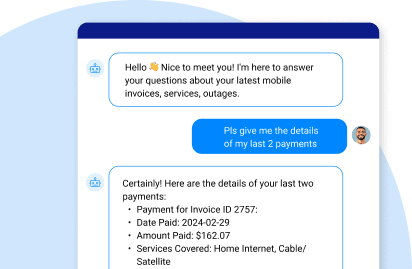Grounding data is the process of exposing your Large Language Model (LLM) to real-world data to ensure it responds to queries more accurately and reliably.
Grounding data defined
Grounding data, in the context of AI, is a method of connecting your LLM’s knowledge to real-world facts and figures. In theory, grounding AI is like teaching children about dogs by showing them pictures and videos of canines or letting them pet real dogs, rather than trying to define the concept of dogs in words.
LLM grounding involves incorporating data from your company’s own private sources, contextual information, or constraints into the model's inference processes. It’s especially important for chatbot interactions, content creation, and decision support systems, where factual accuracy and an understanding of the real world are essential.
For example, if an LLM is asked the name of the CEO of your company, grounding allows it to access data from both internal enterprise systems and external web-based sources. This “multi-checking” mechanism ensures that your AI model will consistently provide the right answer instead of coming up with yet another LLM hallucination.
AI data grounding addresses several challenges
AI is truly groundbreaking technology. By analyzing vast datasets, Large Language Models (LLMs) learn patterns that enable them to generate content that closely resembles the data on which they were trained.
Grounding AI data is like building a bridge between theoretical and actual outcomes, ensuring:
-
Real-life interaction
Grounding data helps your LLM understand and use real-world data, making its responses more accurate and reliable.
-
Context relevance
It enhances your LLM’s ability to generate contextually relevant answers by connecting abstract concepts to real-world examples.
-
Error reduction
Grounded LLMs are less likely to produce AI hallucinations, because they’re anchored to trusted sources of information.
-
Flexibility
LLM grounding allows AI models to adapt to change more effectively and maintain their value over time.
Techniques for grounding LLM data
There are many techniques used by AI developers and researchers to ground LLM data, including:
-
Pre-training on publicly available data
When LLMs are pre-trained on large datasets from diverse sources, their foundational knowledge is enhanced – along with the quality of their basic responses.
-
Implementing Retrieval-Augmented Generation (RAG)
Retrieval-augmented generation works by pairing your LLM with a retrieval model that pulls relevant internal data from various sources in real-time during the response generation process. RAG tools that inject LLMs with trusted enterprise data ensure that your model’s responses are as contextually accurate and up to date as possible.
-
Fine-tuning on domain-specific data
In a retrieval-augmented generation vs fine-tuning comparison, fine-tuning exposes LLMs to external, domain-specific datasets like medical texts, legal documents, or technical manuals. Fine-tuning enhances understanding in specific contexts, making LLM outputs more reliable in specialized areas.
-
Incorporating external knowledge bases
LLMs can be linked to external sources like scientific databases, or industry-specific knowledge bases. Like active retrieval-augmented generation, such connections allow the LLM to retrieve and incorporate factual information during response generation.
-
Getting human feedback
A human in the loop can provide immediate feedback on LLM outputs, which is then used to refine the model. This iterative model improvement corrects the LLM's behavior based on real-world inputs from actual people.
-
Post-processing and validating
This technique conducts post-processing checks that validate LLM outputs, ensuring they meet specific criteria or thresholds. It’s designed to catch and correct errors before the final response is delivered.
The future of grounding data
Grounding data holds immense promise. As grounding techniques advance, future AI models will become increasingly more accurate and reliable – enabling their application to an even wider range of industries and domains.
Advancements in grounding data will be focused on developing more efficient algorithms for data processing, improving data quality assessment, and exploring hybrid approaches that combine different data grounding techniques. What’s more, research will concentrate on addressing practical challenges, such as bias mitigation and privacy issues.
Grounding data with GenAI Data Fusion
GenAI Data Fusion is an innovative suite of RAG tools developed by K2view that grounds LLM data to such an extent that RAG hallucinations are practically non-existent. It aggregates all the data related to a single business entity (customer, employee, invoice, etc.) based on a generative data product approach.
Generative data products are AI-ready by design with complete, compliant, and current data. They enable your generative AI apps to leverage RAG to integrate your customer 360 or product 360 data from your own trusted sources and turn it into contextual prompts. The prompts are fed into your LLM, together with the user’s query, enabling the model to generate a more contextual and personalized response.
K2View data product platform powers RAG access to data products via API, CDC, messaging, or streaming – in any combination – to unify data from a wide variety of different source systems. The data product-RAG solution leads to:
-
Quick problems solving
-
Hyper-personalized marketing campaigns
-
Insightful cross-/up-sell recommendations
-
Instant fraud detection based on unusual activity in user accounts
When it comes to grounding AI data, look no further
than GenAI Data Fusion, the K2view suite of RAG tools.













